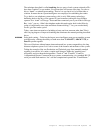Chapter 5 - Design of Matrix Intercom Systems 73
The technique described is called trunking; the two ports of each system assigned to PLs
have been “trunked” to one another. For reasons that will become clear later, we refer to
this as “dumb” or unintelligent trunking. That isn’t to say that it isn’t a brilliant idea or
solution. It means that no system intelligence was employed in establishing the trunks.
To go back to our telephone system analogy, this is early-20th century technology,
harkening back to the days of an operator in your hometown asking the long distance
operator for a “trunk” to Chicago. That trunk then connected you to your Aunt in Chicago.
But, “wait,” you say, “didn’t the telephone make this much easier back in the fifties by
going to long distance area codes and direct distance dialing?” Yes, you are absolutely
correct, give the reader a prize!
Today, some intercom matrices (including at least one from someone other than Telex)
offer varying degrees of improved trunking that eliminates the manual patching described
above.
WARNING
Sales pitch coming – Telex has the largest, most intelligent, most proven trunking system
available today, offering the ability to trunk more than 20 ADAM™, ADAM™-CS, or
Zues II systems together.
This can all be done without human intervention and in a system comparable to the long
distance telephone system. Let’s look at some of the features and attributes of the system.
Taking the example of the two Production and Technical party-lines manually trunked
together given earlier, let’s make a couple small changes. Make the “trunking ports”
assignable, and give them the designations “Trunk A” and “Trunk B,” Connect a
“computerized operator” between the two systems, communicating via a standard RS-232
serial port with both matrices. Let’s call the computerized operator the “Trunk Master.”


















